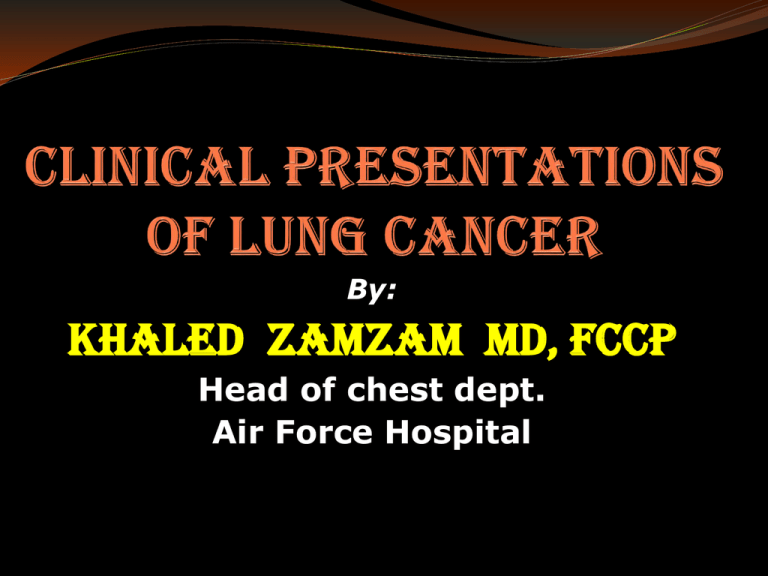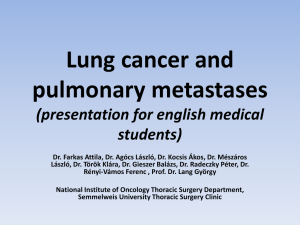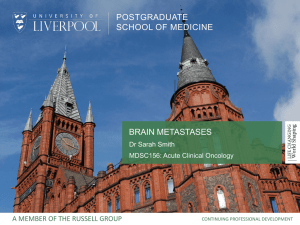
By:
Khaled Zamzam MD, FCCP
Head of chest dept.
Air Force Hospital
The history and physical examination
is an important initial step in
evaluating patients with suspected
lung cancer as it usually will uncover
important information regarding a
patient’s stage of disease and
prognosis and associated medical
complications of the underlying
cancer.
The symptoms and signs of lung
cancer may be caused by:
Local effects of the primary tumor or
Regional lymph node metastases;
distant metastases; or
Paraneoplastic disorders.
The clinical presentation of lung cancer
usually relates to the development of a
new, or worsening of a preexisting
clinical symptom or sign and, less
frequently, to an abnormal CXR shadow
in an asymptomatic patient.
More than 90% of patients with lung
cancer are symptomatic at presentation.
Patients who present with symptoms at
the time of diagnosis have a far worse
outcome than those who do not.
Resectable lung cancer will seldom be
diagnosed based on the medical history.
Approximately 50% of patients will have
demonstrable metastatic lesions or
evidence of unresectability at the time of
the first diagnosis.
Further testing will reveal that another
15% are unresectable.
Finally, another 5 to 10% of patients will
be found to be unresectable at surgery.
Thus, only 25 to 30% of cases are
potentially curable by surgery.
Physical examination findings usually
parallel the symptoms.
The physical examination will become
positive only late in the course of the
disease.
If the first clue to the diagnosis comes
from the physical examination, it is
probably too late to expect any chance
for a cure.
Cough:
Is by far the most common presenting
symptom in patients with lung cancer
(75%).
Is usually mildly productive or even dry.
In some patients it may present as
paroxysmal, while in a minority, those
affected by a secretory bronchoalveolar
carcinoma may be associated with
bronchorrhea, and shortness of breath
out of proportion to the radiographic
findings.
Most patients also present with a chronic
productive cough due to chronic
bronchitis, and in these patients the
initial manifestation of lung cancer
development is a change in the character
of cough or the appearance of blood
tinged sputum.
Dyspnea:
In 60% of cases.
A recent appearance of dyspnea on
exertion or even at rest may be related to
the central (trachea or main bronchus)
development of lung cancer and in this
case is commonly associated with
wheeze.
However, dyspnea may be due to a
variety of factors, including:
Endobronchial disease,
Atelectasis,
Postobstructive pneumonia,
Pleural effusion,
Pulmonary embolus,
Lymphangitic spread.
Arrhythmia or
Tamponade resulting from pericardial
effusion.
Hemoptysis:
In 35% of cases.
Is rarely severe.
Is an important sign in smokers.
If related to the development of lung
cancer, is usually associated with
abnormal CXR.
However, in the case of normal CXR,
further diagnostic examinations are
mandatory in the high risk patient
including, CT, bronchoscopy and
repetitive sputum cytology.
It may also be due to:
Invasion of a large mediastinal vessel
including, the pulmonary artery itself or
one of its branches.
Obstructive pneumonia.
Pulmonary embolism and infarction.
Infiltration of the left pulmonary artery
by a central bronchogenic neoplasm.
Fever:
The tumour itself causes low grade fever,
due to release of pyrogenic cytokines such
as: IL-6, TNF-α.
Obstructive pneumonia: many cases are
sterile and the inflammatory reaction that
leads to parenchymal consolidation is
presumably due to retained secretions.
However, the occurrence of fever is usually
due to secondary infection. If pneumonia
reoccurs in the same side in a high risk
patient is very suspicious of occult lung
cancer.
Postobstructive atelectasis. in the
absence of frank infection.
Chest pain:
Pleural involvement: stitching.
Chest wall involvement: dull aching.
Hoarseness:
In 18% of cases.
May result from vocal cord paralysis in
patients with mediastinal disease
affecting the recurrent laryngeal nerve.
occasionally, patients with massive
mediastinal disease may develop
bilateral vocal cord paralysis, resulting in
stridor due to upper airway obstruction.
Pancost tumour & Horner
syndrome:
According to Pancost’s classic
description, a lung cancer at a definitve
location at the thoracic inlet produces
constant & characteristic phenomena of
pain in the 8th & 1st & 2nd thoracic trunk
distribution, & Horner’s syndrome.
Pancost tumour is quite consistantly a
lung cancer, however other malignancies
as well as inflammatory & infectious
diseases (are rare etiologic conditions)
that develop peripherally at the apex of
the upper lobes, at or near the superior
pulmonary sulcus.
Common & rare conditions
causing Pancost’s syndrome:
Neoplasms:
Lung cancer.
Adenoid cystic carcinoma.
Haemangiopericytoma.
Mesothlioma.
Plasmacytoma.
Lymphomatoid granulomatosis.
Lymphoma – non-Hodgkin.
Thyroid carcinoma.
Metastatic neoplasms.
Infections:
Staphylococcus aureus, Pseudomonas
aeruginosa.
Tuberculosis.
Nocardiosis, Actinomycosis.
Hydatid cyst.
Pasteurella multocida.
Mucoromycosis, asegilloma. Cryptococcus
neformans.
Mycotic aneurysm.
Miscellaneous:
Cervical rib syndrome.
Thyroid cyst.
Amyloidoma.
Smpathetic dystrophy.
Constrained by the narrow confines of
the thoracic inlet, the developing
carcinoma invades the lymphatics of the
endothoracic fascia and involves by
direct extension one or more of the
following structures:
The lower roots of the brachial plexus.
The intercostal nerves.
The stellate ganglion.
The sympathetic chain.
Adjacent ribs & vertebrae.
It’s initial clinical picture is pain localized
to the shoulder & the vertebral border of
the scapula.
Later the pain extends down the arm
towards the elbow, along the distribution
of the ulnar nerve (T1 nerve root
involvement) and subsequently to the
ulnar surface of the forearm and the
small ring finger of the hand.
Weakness & atrophy of the muscles of
the hand supervenes, as well as the loss
of the triceps reflex.
When the lung cancer invades the
sympathetic chain and the stellate
ganglion, Horner’s syndrome
(enophthalmos, meiosis, ptosis, &
anhidrosis) develops on the ipsilateral
side of the face.
Adjacent bone involvement increases the
severity of the pain.
Invasion of the spinal canal & spinal cord
leads to spinal cord compression
syndrome.
The vast majority of superior sulcus
tumours are due to NSCLC & can be
staged as T3N0M0 ( stage IIB) or higher.
T3 refers to the direct invasion of the
chest wall.
T4 refers to the direct invasion of the
mediastinum, great vessels, the
eosophagus, the trachea, vertebral body,
or the heart.
• CXR: homogenous opacty in left
lung apex.
• CT: osteolysis of the adjacent rib.
• MRI: infiltration of the lower
scalene muscle & brachial
plexus.
Left Horner’s
syndrome
SVC syndrome:
The SVC is a 6–8cm long, thin-walled,
low-pressure vessel that drains venous
blood from the head, neck, upper
extremities, and upper thorax to the
heart.
It extends from the junction of the right
& left innominate veins to the right
atrium.
It is located in the middle mediastinum
and is surrounded by:
The sternum.
Trachea.
Right bronchus.
Aorta.
Pulmonary artery.
Perihilar & paratracheal L.N.
Several space-occupying lesions in the
middle mediastinum may compress or
invade the vessel, leading to blood flow
reduction or complete obstruction.
In such conditions, intravascular
thrombosis quite constantly coexists.
SVC syndrome is the clinical syndrome
that results from the homonymous vessel
obstruction or the severe reduction of
venous return from the head, neck, &
upper ext.remities.
Common & rare conditions
causing SVC syndrome:
Neoplasms:
Lung cancer (70%).
Lymphomas, non-Hodgkin or Hodgkin.
Metastatic cancers.
Teratoma, Hamartoma, cystic hygroma,
thymoma.
Thyroid carcinoma.
Choriocarcinoma,
Aparaganglioma, neurogenic tumour,
Schwannoma.
Melanoma, lymphocytic leukemia
Infections:
Tuberculosis.
Histoplasmosis.
Syphilis.
Aspergillosis.
HIV infection.
Actinomycosis & Nocardiosis.
Klebsiella pneumoniae.
Hydatid cyst.
Vascular conditions:
Thromboembolism.
Catheter related: e.g., pacemakers,
defibrillators.
Pericarditis.
Aortic aneurysm, right sunclavian
aneurysm, innominate artey aneurysm.
Budd – Chiari syndrome..
Behcet’s disease.
Vasculitis.
A-V fistulas.
Leucocytoclastic vasculitis.
Heparin induced thrombosis.
Thoracic outlet syndrome.
Miscellaneous:
Fibrosing mediastinitis.
Encapsulated pleural effusion.
Sarcoidosis.
Cystic fibrosis.
Retrosternal goitre.
Postsurgery.
Clinically, it presents with head, facial,
neck, upper thorax, and upper extremity
edema and venous distension.
Headache, cyanosis, and the formation of
an extensive collateral circulation.
Bending forward or lying down
aggravates symptoms & signs.
Laryngeal edema and in severe cases,
stuper and coma may ensue.
Because of the localization of the
causative process in the mediastinum,
SVC syndrome may coexist with other
mediastinal syndromes such as,
dysphagia, vocal horseness, & dyspnea
due to large airway obstruction.
the obstruction develops slowly, allowing
the development of a collateral venous
system that is evident at the time of the
physical examination.
The severity of the SVC syndrome
depends upon the the rapidity of
occlusion and collateral vessel
development.
Collateral venous return to the heart, in
the case of obstruction, occurs through 4
principal pathways:
1) The azygos venous system: Azygos
vein, Hemiazygos vein, & the connecting
intercostal veins.
2) The internal mammary venous system:
plus the tributaries and the secondary
communications to the superior &
inferior epigastric veins.
3) & 4) The long thoracic venous system
and its connections to the femoral &
vertebral veins, respectively.
In the absence of tracheal compression and
airway compromise, it is rarely an oncologic
emergency.
In the majority of cases there is enough time
to obtain an etiological diagnosis and decide
upon adequate & specific management.
Chemotherapy & radiotherapy are effective
in relieving symptoms in lung cancer-related
SVC syndromes.
The insertion of stents may provide a more
rapid relief.
• CXR: Opacity in the right upper lobe with extensive basis
in mediastinum
• CT( contrast enhanced): Mass compressess &
circumscribes the SVC, also evident the azygos dilatation.
Sequential venous angiograms, before (left), during (middle, PRESTENT),
and , after placement of the stent (right, POSTSTENT)
Recurrent laryngeal &
phrenic nerve palsy:
Compression, entrapment, or invasion of
the recurrent laryngeal nerve by the
primary cancer or its nodal metastases
around the aortic arch, leads to
horseness.
Horseness is an uncommon sign at
presentation & appears late in the
natural history of the disease.
Recurrent laryngeal nerve palsy
predisposes to lung aspiration and is
associated with ineffective ability to
cough and expectorate.
Rarely, recurrent laryngeal nerve palsy
manifests with dysphagia both for solids
& liquid foods, since this nerve
contributes to the innervation of the
cricoid muscles & the proximal
esophagus.
Neoplastic involvement can also affect
the phrenic nerve.
Clinically, phrenic nerve palsy may be
asymptomatic in patients with good
respiratory reserve, or may manifest with
dyspnea on exertion or even at rest in
the respiratory compromized patient.
Lung cancer is the leading cause of
malignant pleural effusion. A pleural
effusion is observed in 15% of patients
at their first evaluation.
However, during the course of the
disease at least 50% of patients with
diseminated disease will develop a
pleural effusion.
The mechanisms by which a lung cancer
leads to pleural effusion may be:
Direct.
Indirect.
Direct mechanisms:
Pleural metastatic involvement, inducing
increased pleural permeability.
Pleural lymphatic obstruction by metastases,
decreasing pleural fluid drainage.
The mediastinal LN involvement that also
leads to decrease pleural lymphatic
drainage.
The thoracic duct interruption that leads to
chylothorax.
Large bronchial obstruction leads to
atelectasis, decreasing intrapleural pressure,
thus increasing fluid formation.
Indirect mechanisms:
Hypoproteinemia.
Postobstructive pneumonitis.
Pulmonary embolism.
Postradiation therapy.
The most common sites of metastasis of
lung cancer are:
The adrenal glands,
Liver,
Central nervous system (CNS), and
Bone.
Adrenal metastases are quite common in
patients with (NSCLC) but rather
uncommon in patients with (SCLC).
Adrenal metastases are rarely
symptomatic, are not typically associated
with any findings on physical
examination, and are usually only
discovered on routine radiographic
studies (chest radiography and CT of the
chest).
Occasionally, however, massive adrenal
metastases can cause flank pain. In
addition, patients with advanced bilateral
adrenal metastases may develop
symptoms of adrenal insufficiency.
Liver metastases occur frequently in
patients with lung cancer, more
commonly with SCLC than with NSCLC.
The symptoms of hepatic metastases
may include jaundice and right upper
quadrant pain associated with the
findings of hepatomegaly and liver
tenderness on examination.
However, these findings usually occur
only in patients with very advanced liver
disease.
More commonly, hepatic metastases
present with less specific symptoms,
such as anorexia, malaise, and weight
loss.
Metastases to the CNS are commonly seen in
both SCLC and NSCLC (particularly
adenocarcinoma).
While CNS metastases are often
asymptomatic and discovered only
incidentally during radiographic evaluation,
there are certainly many symptoms and
physical findings related to CNS involvement
that the clinician should be attuned to when
doing the baseline history and physical
examination.
Symptoms of brain metastases may
include:
headache,
Altered mental status,
Seizure,
Nausea and vomiting,
Focal motor or sensory deficits,
Cranial nerve palsies, and
Cerebellar symptoms, such as ataxia.
Another form of CNS metastasis from
lung cancer is involvement of the spinal
cord.
This may occur in the form of spinal cord
compression (usually due to direct
extension of vertebral body metastases
into the spinal canal), intramedullary
metastases (relatively uncommon), or
leptomeningeal seeding of the spinal
canal.
Spinal cord compression and
intramedullary metastases are rarely
asymptomatic and should be identified
rapidly as they constitute neurological
emergencies necessitating immediate
treatment.
About 90% of patients complain of back
pain—either localized or radicular—as
their first symptom.
At diagnosis, about 75% of patients will
note muscle weakness, and 50% will
have associated sensory loss below the
level of the metastasis.
Bowel or bladder incontinence is another
less common symptom of cord
compression.
On physical examination, patients with
spinal cord compression typically have
back tenderness at the site of metastasis.
Other associated findings on physical
examination may include:
Sensory loss or paresis below the level of
the metastasis,
Decrease in anal sphincter tone,
Muscle spasticity, and
Abnormal deep tendon reflexes.
Leptomeningeal metastases are most
commonly seen with adenocarcinoma of
the lung.
Symptoms and physical findings
associated with this relatively uncommon
complication may include:
Headache, seizure, altered mental status,
cranial nerve deficits (typically involving
multiple nerves bilaterally), radicular pain,
and incontinence.
Skeletal metastases occur in about one
third of patients with lung cancer.
Patients with bone metastases often
complain of pain and are found to have
bone tenderness on physical
examination.
Many patients, however, may be
asymptomatic, with this finding
discovered incidentally on a routine bone
scan or because of elevated alkaline
phosphatase levels or hypercalcemia.
Bone marrow involvement, which may
occur with SCLC but is uncommon with
NSCLC, may result in nonspecific
symptoms of fatigue.
Thank you










